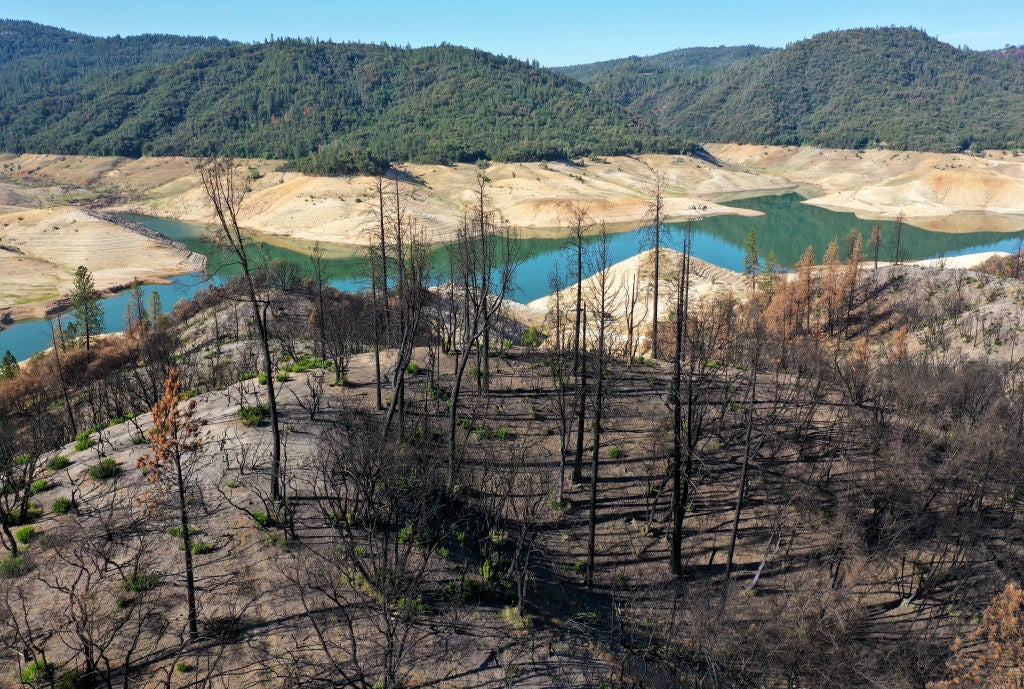This is what California’s ‘mega-drought’ looks like up close
Lake Oroville in northern California, which helps irrigate 25 per cent of all US crops and power major hydroelectric plants, is sitting at about 37 per cent capacity, writes senior climate correspondent Louise Boyle


Even if you care deeply about the climate crisis, the barrage of daily headlines can be hard to wrap your mind around.
Take the “mega-drought” currently gripping California, for instance. The Golden State’s reservoirs are 50 per cent lower than usual this time of year, a situation so perilous that an emergency has been declared in 41 of 58 counties.
Alarming figures but what does that mean on the ground? I had a first-hand look earlier this month in Butte County while reporting on California’s looming wildfire season.
Butte County, north of Sacramento, is a slower-paced, more rural part of California than its flashy cousins to the south. It’s also home to some of the most horrific wildfires in recent memory. The 2018 Camp Fire was the deadliest in California’s history, killing 85 people and destroying 95 per cent of structures in Paradise and neighbouring towns. Last year’s deadliest California wildfire, which claimed 16 lives, also struck in this area.
Lake Oroville sits at the heart of the county. The state’s second largest lake was created by the construction of America’s tallest earthen dam. It’s described as the “linchpin” of a network of aqueducts and reservoirs, California’s insurance policy through baking, arid summers.
The lake helps irrigate 25 per cent of all US crops and sustains an endangered salmon population. The water also runs major hydroelectric plants that power California. Not to mention it’s a wildly popular recreation spot with locals and tourists alike.
Now the tree line, where many trunks have been burned by wildfire, sits almost ludicrously high on steep, dusty slopes with the sparkling water far below.
Curiosity got the better of me and I paid a visit to Lime Saddle Marina in Paradise. In the parking lot, dozens of houseboats were raised on blocks. It took 10 minutes to walk down a concrete slip to reach the water, lined with SUVs blasting country rock and air conditioning as they waited to tow away boats on the 85F day.
At the bottom, as I watched two men struggle to load a speedboat from the water’s edge onto a trailer, I ran into Tony Davis, a manager at the marina. He estimated that the water level was now around 200ft below the tree line. (As of Monday, Lake Oroville was at 37 per cent of its capacity.)
The climate crisis is the backdrop to California’s interwoven issues of soaring temperatures, drought, and wildfires. Rain has decreased by about a third during fall months in the last 40 years. Southern California has warmed 3F in the last century and temperature averages are rising statewide, says the US Environmental Protection Agency.
Mr Davis calls the climate impacts “pretty undeniable”.
“We haven’t had half the rain we’re supposed to get, and half the snowpack. It makes it really hard when we don’t have water,” he said.
Early in 2021, state officials were caught off-guard when about half a million acre-feet of water expected to flow into reservoirs did not materialise. An acre-foot of water can typically meet the indoor and outdoor needs of one to two average households for a year.
Temperatures also hit triple digits across large swathe of California at the end of May, earlier than expected.

Forecasts show Lake Oroville could reach a record low this summer. If the water level drops under 640ft, which state authorities believe is possible in August, a major power plant would need to be shut down, adding strain to the electrical grid at the hottest part of the year and in peak fire season.
It will also mean the state will have to close boat ramps for the first time ever because of low water levels, Aaron Wright, public safety chief for the Northern Buttes District of California State Parks told the AP.
Mr Davis said around 48 houseboats had already been pulled out of the water at Lime Saddle, and a nearby marina had removed 80 vessels. In the weeks since, that number has more than doubled at Lake Oroville.
“When the lake is up high, it's beautiful and an awesome environment,” Mr Davis said. “Now because we don't have any water, it's potentially a financial hardship on people.
“It breaks my heart because people put a lot of time, effort and money into this and they can't enjoy it.”



Join our commenting forum
Join thought-provoking conversations, follow other Independent readers and see their replies
6Comments